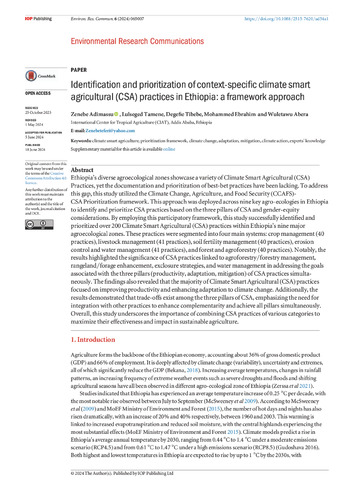Identification and prioritization of context-specific climate smart agricultural (CSA) practices in Ethiopia: A framework approach
Ethiopia's diverse agroecological zones showcase a variety of Climate Smart Agricultural (CSA) Practices, yet the documentation and prioritization of best-bet practices have been lacking. To address this gap, this study utilized the Climate Change, Agriculture, and Food Security (CCAFS)-CSA Prioritization framework. This approach was deployed across nine key agro-ecologies in Ethiopia to identify and prioritize CSA practices based on the three pillars of CSA and gender-equity considerations. By employing this participatory framework, this study successfully identified and prioritized over 200 Climate Smart Agricultural (CSA) practices within Ethiopia's nine major agroecological zones. These practices were segmented into four main systems: crop management (40 practices), livestock management (41 practices), soil fertility management (40 practices), erosion control and water management (41 practices), and forest and agroforestry (40 practices). Notably, the results highlighted the significance of CSA practices linked to agroforestry/forestry management, rangeland/forage enhancement, exclosure strategies, and water management in addressing the goals associated with the three pillars (productivity, adaptation, mitigation) of CSA practices simultaneously. The findings also revealed that the majority of Climate Smart Agricultural (CSA) practices focused on improving productivity and enhancing adaptation to climate change. Additionally, the results demonstrated that trade-offs exist among the three pillars of CSA, emphasizing the need for integration with other practices to enhance complementarity and achieve all pillars simultaneously. Overall, this study underscores the importance of combining CSA practices of various categories to maximize their effectiveness and impact in sustainable agriculture.

